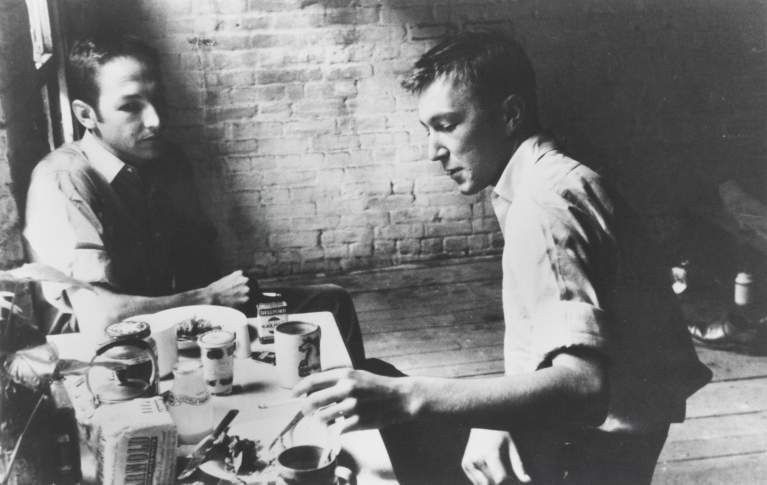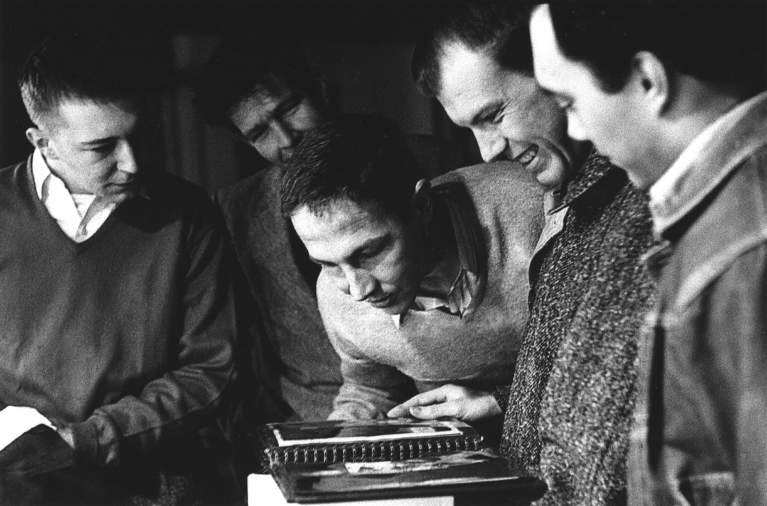1950-59
1955
Continues to work on Combines: Bed (1955) is composed of a quilt, taken at Black Mountain College, near Asheville, North Carolina, from artist Dorothea Rockburne, that he stretches over a board and paints (at the time, he does not have enough money to buy canvas). Rauschenberg also applies red fingernail polish and striped toothpaste to the work. Odalisk (1955/1958), in which female imagery is prevalent, is a counterpart to the earlier Untitled (ca. 1954). Elements include a miniature blueprint of the full-size blueprint Female Figure (ca. 1950), as well as photographs of pinup girls and a reproduction of a figure in Titian’s Pastoral Concert (ca. 1510–11). Rather than the Plymouth Rock hen of Untitled (ca. 1954), a stuffed Plymouth Rock rooster sits atop the work. Rauschenberg will return to Odalisk in 1958 to adjust the electric-light elements. Monogram (1955–59) will evolve through three states, documented in drawings and photographs, before its completion in 1959. The work originates with a stuffed Angora goat that Rauschenberg purchases from a used furniture store. In its first state (1955–56), the goat stands on a shelf attached to a Combine painting that is later reworked and entitled Rhyme (1956).
January 1: Rauschenberg arranges a concert by composer Morton Feldman, a member of Cage’s circle, during the run of his exhibition at the Egan Gallery, New York. The event—Feldman’s first public performance of his own compositions—will later become known as the “Morton Feldman Concert with Paintings.”
March 15: Premiere of Paul Taylor’s solo dance performance Circus Polka (the work will be enlarged into Little Circus, which will premiere on June 6), Master Institute Theater, New York, for which Rauschenberg designed the costumes and set. The costumes include a necklace of cow bones for the ringmaster and a two-man horse outfit.
April 26–May 21: For the 4th Annual Exhibition of Painting and Sculpture at Stable Gallery, New York, Rauschenberg enters Short Circuit (1955), a work protesting the absence of the artists for whom he had recommended, and who had never exhibited in the previous annuals (the policy of this annual series is for past participants to suggest new artists). Rauschenberg asked four artists—Jasper Johns, Ray Johnson, Stan VanDerBeek, and Susan Weil—for works to be added to his larger painting, but only two paintings were ready for inclusion: a small encaustic flag painting by Johns and an oil painting by Weil. Rauschenberg also incorporates an early John Cage concert program and Judy Garland’s autograph into the larger work. Wooden doors marked “do not open” conceal Johns’s and Weil’s works. Johns’s painting will be stolen from the work while on exhibit in 1965, and Rauschenberg will replace it with a facsimile created by Elaine Sturtevant in 1967.
May 24: Premiere of Merce Cunningham Dance Company’s Springweather and People, Bard College, Annandale-on-Hudson, New York. Rauschenberg collaborates with Remy Charlip, Ray Johnson, and Vera Williams on the costume designs, which he will redesign in 1957.
Summer: Creates Rebus (1955), a Combine painting, on drop cloths (later remounted on canvas), which incorporates magazine illustrations, comic strips, and political posters to refer to a contemporary urban world dominated by mass media. As Rauschenberg later explains, the work is intended to be “a concentration of that particular week in that particular neighborhood.”20 It is painted with what he terms a “pedestrian color,”21 whereby no color stands out or is determined by his own personal taste but rather resembles the blur of colors one encounters on the street. The lighter, more open ground will be common in works from 1956–58.
September: Moves from Fulton Street to top floor studio at 278 Pearl Street, New York, where artist Rachel Rosenthal had lived. Johns’s studio is one floor below in the same building, and Rauschenberg and Johns see each other daily, exchanging ideas and discussing their work.
[Fall]: Continues to support himself by preparing window displays in New York for Bonwit Teller and Tiffany & Co. With Johns as partner, forms Matson Jones–Custom Display; “Matson” is Rauschenberg’s mother’s maiden name and “Jones” stands for Johns.
October 15: Meets director and producer Emile de Antonio at an evening of performances by Merce Cunningham and Cage, organized by de Antonio, Clarkstown High School, New City, New York.
November 29–December 23: Participates in U.S. Painting: Some Recent Directions, Stable Gallery, New York, organized by Thomas B. Hess, editor of Artnews. Exhibits Untitled (ca. 1954/1958) and – – – – (1950–55). The latter work, originally designated simply with four dashes, is later referred to as Self-Made Retrospective; it is a shallow cabinet inside of which hang miniature versions of Rauschenberg’s 1950–54 paintings: a Red Painting, a white lead painting, a dirt painting, a Gold Painting, a black painting, and a work modeled on paintings exhibited at the Betty Parsons Gallery, New York, in 1951. The work will be dismantled in the late 1950s, and at present two of the original pieces are known to survive; the Parsons-related work, Untitled (1954) was made expressly for Self-Made Retrospective, and it is likely that Untitled [small white lead painting] (ca. 1953) was included as well.

 Rauschenberg and Jasper Johns in Johns’s Pearl Street studio, New York, ca. 1954. Photo: Rachel Rosenthal
Rauschenberg and Jasper Johns in Johns’s Pearl Street studio, New York, ca. 1954. Photo: Rachel Rosenthal

 Rauschenberg with Jasper Johns, John Cage, and others in Rauschenberg’s or Johns’s Pearl Street studio, New York, ca. 1955 Photo: Jerry Schatzberg
Rauschenberg with Jasper Johns, John Cage, and others in Rauschenberg’s or Johns’s Pearl Street studio, New York, ca. 1955 Photo: Jerry Schatzberg
